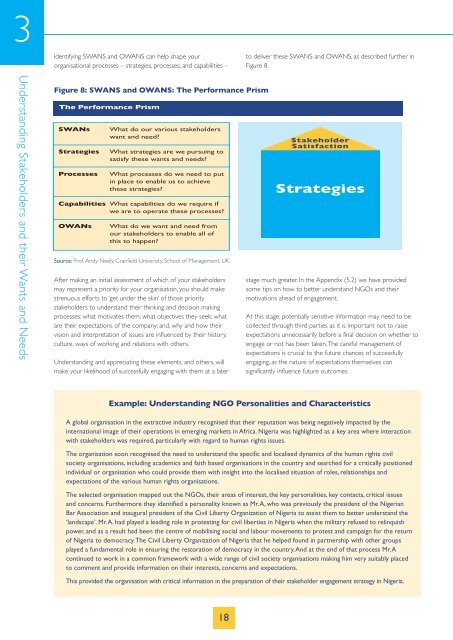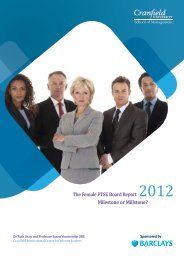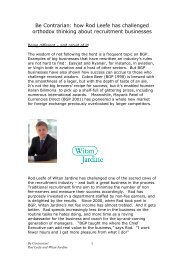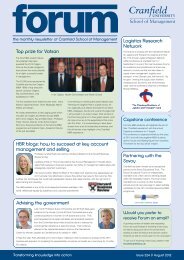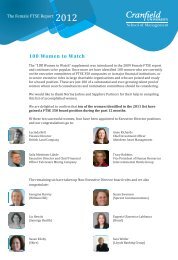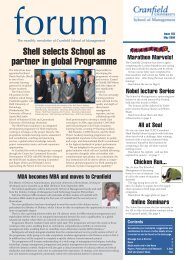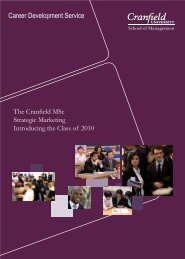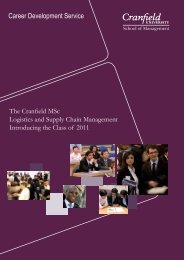Stakeholder Engagement - Cranfield School of Management ...
Stakeholder Engagement - Cranfield School of Management ...
Stakeholder Engagement - Cranfield School of Management ...
You also want an ePaper? Increase the reach of your titles
YUMPU automatically turns print PDFs into web optimized ePapers that Google loves.
3<br />
Understanding <strong>Stakeholder</strong>s and their Wants and Needs<br />
Identifying SWANS and OWANS can help shape your<br />
organisational processes – strategies, processes, and capabilities –<br />
Figure 8: SWANS and OWANS: The Performance Prism<br />
The Performance Prism<br />
SWANs What do our various stakeholders<br />
want and need?<br />
Strategies What strategies are we pursuing to<br />
satisfy these wants and needs?<br />
Processes What processes do we need to put<br />
in place to enable us to achieve<br />
these strategies?<br />
Capabilities What capabilities do we require if<br />
we are to operate these processes?<br />
OWANs What do we want and need from<br />
our stakeholders to enable all <strong>of</strong><br />
this to happen?<br />
Source: Pr<strong>of</strong>. Andy Neely, <strong>Cranfield</strong> University, <strong>School</strong> <strong>of</strong> <strong>Management</strong>, UK.<br />
After making an initial assessment <strong>of</strong> which <strong>of</strong> your stakeholders<br />
may represent a priority for your organisation, you should make<br />
strenuous efforts to ‘get under the skin’ <strong>of</strong> those priority<br />
stakeholders to understand their thinking and decision making<br />
processes: what motivates them; what objectives they seek; what<br />
are their expectations <strong>of</strong> the company; and, why and how their<br />
vision and interpretation <strong>of</strong> issues are influenced by their history,<br />
culture, ways <strong>of</strong> working and relations with others.<br />
Understanding and appreciating these elements, and others, will<br />
make your likelihood <strong>of</strong> successfully engaging with them at a later<br />
18<br />
to deliver these SWANS and OWANS, as described further in<br />
Figure 8.<br />
<strong>Stakeholder</strong><br />
Satisfaction<br />
Strategies<br />
stage much greater. In the Appendix (5.2) we have provided<br />
some tips on how to better understand NGOs and their<br />
motivations ahead <strong>of</strong> engagement.<br />
At this stage, potentially sensitive information may need to be<br />
collected through third parties as it is important not to raise<br />
expectations unnecessarily before a final decision on whether to<br />
engage or not has been taken.The careful management <strong>of</strong><br />
expectations is crucial to the future chances <strong>of</strong> successfully<br />
engaging, as the nature <strong>of</strong> expectations themselves can<br />
significantly influence future outcomes.<br />
Example: Understanding NGO Personalities and Characteristics<br />
A global organisation in the extractive industry recognised that their reputation was being negatively impacted by the<br />
international image <strong>of</strong> their operations in emerging markets in Africa. Nigeria was highlighted as a key area where interaction<br />
with stakeholders was required, particularly with regard to human rights issues.<br />
The organisation soon recognised the need to understand the specific and localised dynamics <strong>of</strong> the human rights civil<br />
society organisations, including academics and faith based organisations in the country and searched for a critically positioned<br />
individual or organisation who could provide them with insight into the localised situation <strong>of</strong> roles, relationships and<br />
expectations <strong>of</strong> the various human rights organisations.<br />
The selected organisation mapped out the NGOs, their areas <strong>of</strong> interest, the key personalities, key contacts, critical issues<br />
and concerns. Furthermore they identified a personality known as Mr.A, who was previously the president <strong>of</strong> the Nigerian<br />
Bar Association and inaugural president <strong>of</strong> the Civil Liberty Organization <strong>of</strong> Nigeria to assist them to better understand the<br />
‘landscape’. Mr.A. had played a leading role in protesting for civil liberties in Nigeria when the military refused to relinquish<br />
power, and as a result had been the centre <strong>of</strong> mobilising social and labour movements to protest and campaign for the return<br />
<strong>of</strong> Nigeria to democracy.The Civil Liberty Organization <strong>of</strong> Nigeria that he helped found in partnership with other groups<br />
played a fundamental role in ensuring the restoration <strong>of</strong> democracy in the country.And at the end <strong>of</strong> that process Mr.A<br />
continued to work in a common framework with a wide range <strong>of</strong> civil society organisations making him very suitably placed<br />
to comment and provide information on their interests, concerns and expectations.<br />
This provided the organisation with critical information in the preparation <strong>of</strong> their stakeholder engagement strategy in Nigeria.


